

|
JunkScience.com
August 23, 2004
Edited for clarity September 13, 2004
Additional graphic and suggestions Jerry Brennan, Still Waiting For Greenhouse
Probably everyone exposed to mass media is familiar with the terms "climate change," "global warming," "greenhouse gas" and "greenhouse effect" so we should be a little more explicit about their meanings and misunderstandings.
To begin with, "climate change" is a fact - no equivocation, climate change is real and perfectly normal. Earth undergoes massive, sometimes ponderous change from major glaciations (ice ages) to interglacial periods (warm and life-friendly periods such as now, this one is called the Holocene). Overlaid on this broad stroke background are innumerable other cycles of periods varied from millennial to seasonal and most only poorly understood. Some examples would be PDO (Pacific Decadal Oscillation - there's also the Atlantic and Southern Indian Oscillations at least, possibly more), ENSO (El Niño Southern Oscillation) and even the regularly anticipated annual seasons. So, climate is constantly changing in lots of ways and the effect depends on the phase of one or more cycles which, if acting simultaneously may be complimentary (giving a compounded or magnified effect) or mutually antagonistic (leading to a muted or even contrary effect). Further complicating matters are solar cycles and apparently random events such as significant volcanic eruptions. So, change is the normal state for climate, quite expected and probably not contentious.
That brings us to "global warming," a term which begs the question "warming relative to when?" A universal answer, which is always true, would be "relative to any [every] time it was cooler." (DUH!) Of course, that isn't how activists and the media have presented such a wooly and undefined term so it deserves slightly less flippant examination. Near-surface thermometer temperature readings have been recorded, in some places for centuries, and these do indicate a longer-term warming trend. What is not often mentioned is that this trend is founded in a period that history tells us was particularly cold and unpleasant, the Little Ice Age (LIA). So, has the globe warmed relative to a baseline in the LIA? Yes. Is this bad? Only if you like crop failures, famine and attendant miseries. Nonetheless, "global warming" is an undefined term and should not be used without qualifiers which render it redundant - it is meaningless.
For the purpose of this document we can specify "greenhouse gas" as molecules in the atmosphere which are largely transparent to incoming (broad spectrum) solar radiation but which absorb outgoing infrared radiation from the Earth. It is important to understand that about half of all incoming (broad spectrum) solar radiation is absorbed by the Earth's surface and reradiated as infrared.
Now we get to "greenhouse effect" and the fact that it, well, isn't. That's not to say it doesn't exist - unequivocally it does - it's just not a "greenhouse effect." Confused? Don't worry, it's just a poor choice of names. We'll deal with this in two parts, beginning with actual greenhouse-type greenhouse effect. A greenhouse (or glasshouse) works by utilizing a physical barrier to interrupt convective heat exchange - incoming solar radiation warms the soil inside the greenhouse, the soil reradiates in the infrared band, some of which is absorbed by greenhouse gasses within the enclosure but the warmed and now less-dense air is not displaced because of the constraining barrier. Some of the infrared reradiated by the captive atmosphere is absorbed by the soil and so we have an accumulative feedback effect within the greenhouse and supported by the constraining barrier - the greenhouse thus warms considerably beyond the external environment. Breaching the barrier, by opening a top window for example, allows the effect to collapse and the rapid return of the enclosed space to near-ambient temperature.
Quite obviously, so-called greenhouse gasses do not act like a physical greenhouse and most assuredly do not inhibit convection. It is, however, perfectly true that greenhouse gasses inhibit Earth's re-radiation of absorbed solar radiation to space as infrared. This is what makes Earth habitable and maintains a warm near-surface envelope in the atmosphere.
According to the enhanced greenhouse hypothesis, human liberation and return to atmosphere of previously sequestered (captured and entombed by biological activity) carbon dioxide (CO2), primarily from fossil fuel burning, and CO2's measured increase in the atmosphere, will cause significant increase in the greenhouse effect with attendant catastrophic surface warming. Further, some suggest various imaginative feedback effects which could supposedly lead to "runaway greenhouse warming" as can be seen on Venus. Our fellow Solar traveler, however, is a very poor example. Venus is so irradiated by the sun that surface temperatures are hot enough to melt lead, there is consequently no liquid water nor biological activity to return carbon to the planet's crust and thus no comparison with Earth.
Well, we can and have measured increase in atmospheric CO2 from pre-industrial levels of about 280ppmv to approximately 375ppmv now (the bulk of the increase occurring since 1950 when it was ~310ppmv). See a graph of the Mauna Loa monthly average CO2 concentrations here (PDF).
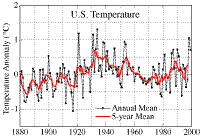 We can and have measured an increase in near-surface temperatures (the bulk of the increase occurring prior to 1950). Thermometer-based near-surface measures are sadly inadequate for determining global mean temperature, firstly because they are not global but include only those few percent of the planet in close proximity to human habitation and secondly because even that small record is heavily influenced by urbanization. Some, possibly most, of this sampling corruption is avoided by radio-sonde balloon measurements as the balloon-mounted assembly escapes the highly localized urban heat island effect (UHIE) into the well-mixed atmosphere. This corrupting influence is almost entirely avoided by satellite-mounted Microwave Sounding Units (MSUs) as we will see shortly. The best-financed and consequently best-maintained near-surface temperature record would have to be the contiguous U.S., you can see a 120-year plot by clicking on the adjacent thumbnail.
We can and have measured an increase in near-surface temperatures (the bulk of the increase occurring prior to 1950). Thermometer-based near-surface measures are sadly inadequate for determining global mean temperature, firstly because they are not global but include only those few percent of the planet in close proximity to human habitation and secondly because even that small record is heavily influenced by urbanization. Some, possibly most, of this sampling corruption is avoided by radio-sonde balloon measurements as the balloon-mounted assembly escapes the highly localized urban heat island effect (UHIE) into the well-mixed atmosphere. This corrupting influence is almost entirely avoided by satellite-mounted Microwave Sounding Units (MSUs) as we will see shortly. The best-financed and consequently best-maintained near-surface temperature record would have to be the contiguous U.S., you can see a 120-year plot by clicking on the adjacent thumbnail.
Of course, the falling temperatures of the 1950s through 1970s caused great consternation and fears of impending ice age. For your amusement, here's a link to a reprint of Newsweek's "The Cooling World."
So, what we know is that:
 For almost 25 years atmospheric temperature has been calculated from data gathered by satellite-mounted MSUs. While this is not long enough to firmly establish a trend it does give us enough data to begin testing the validity of the enhanced greenhouse hypothesis - very loosely stated as increasing atmospheric CO2 = increasing global temperature.
For almost 25 years atmospheric temperature has been calculated from data gathered by satellite-mounted MSUs. While this is not long enough to firmly establish a trend it does give us enough data to begin testing the validity of the enhanced greenhouse hypothesis - very loosely stated as increasing atmospheric CO2 = increasing global temperature.
The adjacent thumbnail links to a graph of Mauna Loa annual mean atmospheric CO2 (rounded to nearest whole part per million) for the appropriate period. As we can readily see there's been a fairly consistent rise in values and so, if the wrongly but oft-claimed "main greenhouse gas" (actually H2O but never mind) and "main driver of global warming" is guilty as charged we should see a similar graph of atmospheric temperature, no?
To be fair, not all advocates of the enhanced greenhouse hypothesis suggest the whole atmosphere will warm, in fact, some are adamant that the stratosphere will cool as the troposphere warms due to greater infrared absorption at lower levels leaving less available energy to warm higher levels. Consequently we examine various levels thus:
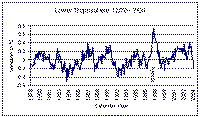
 Here is a graph of the lower troposphere (digital data here). One obvious anomaly occurred with the impressive 1997/98 El Niño event.
Here is a graph of the lower troposphere (digital data here). One obvious anomaly occurred with the impressive 1997/98 El Niño event.
The eruptions of El Chichon in 1982 and Mt. Pinatubo in 1991do not appear to have consistently affected the lower troposphere, associated with warming and cooling respectively - likely the net result of El Niño events conflicting with the eruptions. To the right we have John Daly's graph of 3-month Tropospheric mean temperature anomalies and inverted Southern Oscillation Index (SOI inverted so that negative readings indicating warmer El Niño events plot in the positive range with the temperature anomalies).
At first perusal the lower troposphere plot does not resemble the consistently rising trend of our atmospheric CO2 graph. The SOI appears to do a better job of predicting global temperature but the ENSO (El Niño Southern Oscillation) is certainly not completely dominant as the effect can be reduced (as shown for the El Chichon aftermath) or completely masked (Mt. Pinatubo shading).
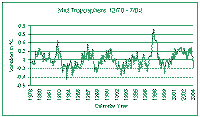
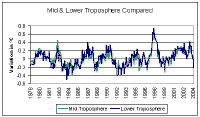 Here's the mid-troposphere monthly mean temperature anomalies (source data)
Here's the mid-troposphere monthly mean temperature anomalies (source data)
As we might have expected it would appear substantially similar to our previous graphic.
Just to prove the point, on the right we have a thumbnail linked to a composite demonstrating just how good is the fit of these two tracks. We will consider the lower troposphere to be representative for the rest of this document.
So, what of the stratosphere? Does it match the troposphere or perhaps the atmospheric CO2 or even a mirror of either? One way to find out:
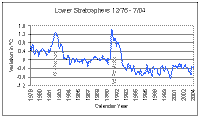 Hmm... well it does seem substantially different - to begin with the responses to the eruptions of El Chichon in '82 and Mt. Pinatubo in '91are quite dramatic. This suggests - but does not prove - that ENSO events do not significantly affect the stratosphere.
Hmm... well it does seem substantially different - to begin with the responses to the eruptions of El Chichon in '82 and Mt. Pinatubo in '91are quite dramatic. This suggests - but does not prove - that ENSO events do not significantly affect the stratosphere.
[Note that this graph range is -1.2 °C - 1.6 °C - twice the range in the previous graphs (here is the source data)]
Having the variation in scale and separate graphs does not make comparison easy so we'll try fitting both data sets on one graph and see what happens:
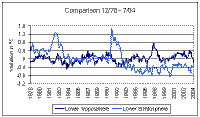
 Well, the lower troposphere might show a similar but much smaller response to El Chichon but nothing for Mt. Pinatubo. The strong tropospheric response to the powerful 1997/98 El Niño does not seem to be reflected in the stratosphere. Referring again to Daly's SOI and temperature graph we suggest that the 1997/98 El Niño event appeared so intense because there were no significant volcanic eruptions to mask the event. We surmise ENSO events affect only the troposphere.
Well, the lower troposphere might show a similar but much smaller response to El Chichon but nothing for Mt. Pinatubo. The strong tropospheric response to the powerful 1997/98 El Niño does not seem to be reflected in the stratosphere. Referring again to Daly's SOI and temperature graph we suggest that the 1997/98 El Niño event appeared so intense because there were no significant volcanic eruptions to mask the event. We surmise ENSO events affect only the troposphere.
Parenthetically, the obvious and near-immediate lower atmosphere response to the 1997/98 El Niño event, lagging only a few months and accurately tracking the strength of that anomaly severely tramples the "thermal inertia" excuse of model apologists. Since global temperatures waxed and waned in direct response to a strong but transient event we can now say with certainty that the atmosphere categorically does not take decades to react - it's the models that are broken.
 Before we leave the comparison of lower troposphere and lower stratosphere temperature anomalies, we should just test to see what kind of fit we get if we look for "mirroring" - a cooling of the stratosphere in response to a warming of the troposphere.
Before we leave the comparison of lower troposphere and lower stratosphere temperature anomalies, we should just test to see what kind of fit we get if we look for "mirroring" - a cooling of the stratosphere in response to a warming of the troposphere.
Instead of trying to measure divergence we've simply inverted the lower stratosphere "worm" to see if we get a "fit" similar to our lower and mid-troposphere composite above. While we would not expect amplitude to be any sort of precise mirror the direction of change should now match if the mirror hypothesis is valid.
Regardless of volcanic- and ENSO-induced peaks the result is not compelling.
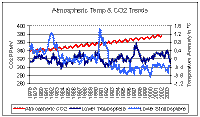 Finally, we can look at atmospheric CO2 (in monthly format this time, showing the enormous Northern Hemisphere absorption during the growing season) along with both lower troposphere and lower stratosphere monthly mean temperature tracks.
Finally, we can look at atmospheric CO2 (in monthly format this time, showing the enormous Northern Hemisphere absorption during the growing season) along with both lower troposphere and lower stratosphere monthly mean temperature tracks.
Pretty as these graphics may be there does not seem to be any direct relationship between the tracks. It is quite true that atmospheric CO2 has increased fairly consistently. It is true that the lower stratospheric temperature has decreased when not influenced by major volcanic eruptions but it is and has been (relatively) stable (in fact, warming slightly) over the last decade even though atmospheric CO2 has continued its steady trend. Lower tropospheric temperatures have been a trifle erratic but again show no discernable correlation to atmospheric CO2 levels.
In conclusion, satellite-mounted MSUs are providing a wealth of information regarding the globe's temperature, of much greater value than the near-surface record, both more accurate and much more widely sampled than any other method. While a quarter-century of data is still insufficient to ascertain trends with any accuracy we can readily establish that atmospheric CO2 and atmospheric temperature are poorly correlated.
To answer our originally posed question: "The atmosphere and enhanced greenhouse - what's happening?" the answer must be: "nothing consistent." Is atmospheric CO2 increasing? Yes. Is it apparently driving temperature? No, it doesn't seem so.
Copyright © 2004 JunkScience.com - All Rights Reserved.
This article, including graphics, may be reprinted in full or in part with attribution.